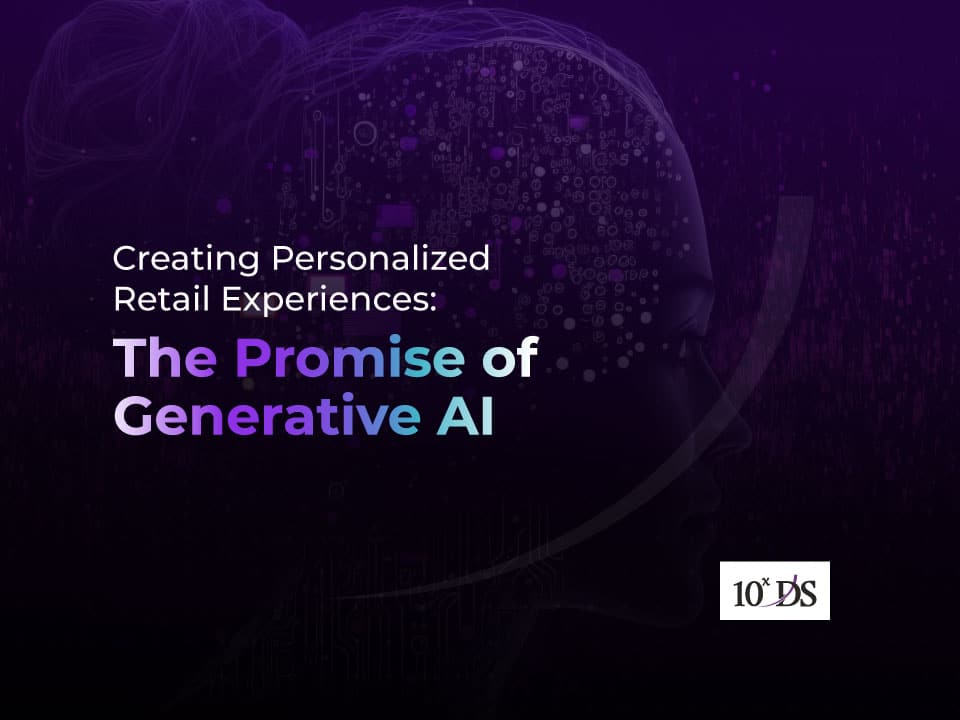
Creating Personalized Retail Experiences: The Promise of Generative AI
The retail sector is constantly evolving, facing various challenges that require innovative solutions. Artificial Intelligence (AI), with its ability to create, analyse, and generate content, has emerged as a powerful tool to address these challenges. By leveraging the capabilities of AI, retailers can enhance customer experiences, optimize operations, and stay ahead in a highly competitive market. Mordor Intelligence reports that the AI in Retail Market size is expected to grow from USD 7.30 billion in 2023 to USD 29.45 billion by 2028, at a Compound Annual Growth Rate (CAGR) of 32.17% during the forecast period (2023-2028). Off late, retailers are offering a wide range of applications, from personalized product recommendations and virtual try-on experiences to inventory optimization and fraud detection. In this article, we will explore how AI, specifically generative AI can be employed to tackle the current challenges faced by the retail sector and unlock new opportunities for growth and success.
Virtual Try-On
Generative AI can be used to create virtual try-on experiences, allowing customers to see how a product will look on them without physically trying it on. By analysing customer images or using 3D models, the AI generates a realistic representation of the customer wearing the product. It can also seamlessly integrate virtual products into live camera feeds or uploaded images, allowing customers to visualize how products will appear in their real environment. Accurate sizing and fit and product variation exploration can be tackled with this technology which will push the e-commerce sector to new boundaries.
Personalized Product Recommendations
Generative AI is a powerful tool for creating personalized product recommendations in the retail sector. Generative AI algorithms can analyse customer data such as purchase history, browsing behaviour, demographic information, and contextual data to create detailed customer profiles. By applying techniques like collaborative filtering and clustering, the AI system can group customers with similar tastes, enabling recommendations based on what others with similar profiles have liked or purchased. Content Analysis, Contextual Recommendations, Cross-Selling and Upselling, Real-Time Adaptation on feedback etc are also techniques that help in personalized recommendations.
Visual Search
With generative AI, retailers can develop visual search capabilities. Generative AI helps in Image Understanding, Feature Extraction, Indexing and Matching, Multimodal Integration and Object Recognition and Localization. Customers can upload images or take pictures of products they are interested in, and the AI system can generate relevant search results based on the visual features of the input image.
Virtual Shopping Assistants
Generative AI is revolutionizing virtual shopping assistance by simulating conversational agents that engage with customers in a personalized and informative manner. Using natural language processing, the AI-powered assistants understand customer queries, provide detailed product information, offer personalized recommendations, and guide customers through their shopping journey. They can showcase virtual product demonstrations, suggest outfits based on individual styles and preferences, provide size and fit recommendations, and even track orders and offer customer support. By emulating the expertise of human sales associates and leveraging advanced algorithms, generative AI enhances the virtual shopping experience, driving customer engagement, satisfaction, and ultimately, boosting sales conversion for retailers.
Content Generation
Generative AI is transforming content generation in the retail industry by automating the creation of compelling and informative text. Leveraging advanced language models, generative AI can generate product descriptions, blog articles, social media posts, and other retail content. By training on vast amounts of data, the AI system can produce text that captures the brand voice, showcases product features, and engages customers. This streamlines content production processes, improves efficiency, and ensures consistent messaging across different channels. Generative AI-powered content generation enables retailers to deliver high-quality and relevant content at scale, enhancing customer experiences and driving marketing effectiveness in the dynamic retail landscape.
Inventory Optimization
By analysing historical sales data, market trends, customer behaviour, and other relevant factors, generative AI can generate accurate demand forecasts and suggest optimal inventory levels. The AI system identifies patterns, seasonality, and correlations in the data, allowing retailers to make data-driven decisions regarding stock replenishment, order quantities, and allocation. By minimizing overstocking and understocking issues, generative AI-powered inventory optimization improves operational efficiency, reduces costs, and ensures that products are available to meet customer demand, ultimately enhancing customer satisfaction and maximizing profitability.
Dynamic Pricing
Analysing factors such as customer behaviour, market trends, competitor pricing, and demand fluctuations, helps generative AI generate pricing recommendations that maximize sales, revenue, or profit margins while remaining competitive. The AI system identifies pricing patterns, seasonality, and customer preferences, allowing retailers to dynamically adjust prices based on market conditions and customer demand. By optimizing pricing in real-time, generative AI-powered dynamic pricing enhances revenue generation, improves competitiveness, and enables retailers to capture the most value from their products and services, ultimately driving business growth and success.
Fraud Detection
The AI system learns from historical data to understand normal patterns and behaviours, enabling it to identify anomalies and suspicious activities that may indicate fraudulent behaviour. By continuously monitoring and analysing large volumes of data, generative AI-powered fraud detection systems can provide timely alerts and insights to retailers, allowing them to take immediate action to mitigate risks, prevent financial losses, and protect their business and customers from fraudulent activities.
These are just a few examples of how generative AI can be applied in the retail industry. The potential for innovation and transformation using AI is vast, and these applications have the potential to enhance customer experiences, improve operational efficiency, and drive business growth. Amazon uses generative AI algorithms to power its recommendation engine, providing personalized product recommendations to customers based on their browsing and purchase history. They also leverage generative AI for inventory management, demand forecasting, and dynamic pricing strategies. Walmart leverage AI for demand forecasting, inventory management, and replenishment to ensure products are available when and where customers need them, reducing stockouts and optimizing inventory levels. JD.com, a leading e-commerce platform in China, uses generative AI for dynamic pricing strategies. Their AI algorithms analyse real-time market data, competitor pricing, and customer demand to dynamically adjust prices, optimizing revenue and profit margins.
The future of the retail industry with generative AI promises a revolution in customer experiences, operational efficiency, and business growth. AI-powered generative models will deliver hyper-personalized recommendations, immersive virtual shopping experiences, and seamless omnichannel integration. Retailers will optimize inventory management and supply chains through AI-driven demand forecasting, dynamic pricing, and real-time stock replenishment. Enhanced fraud detection systems will safeguard against fraudulent activities, ensuring customer security. Generative AI will empower retailers with data-driven insights for strategic decision-making, from assortment planning to targeted marketing campaigns. By leveraging the potential of generative AI, the retail industry will unlock unprecedented levels of personalization, convenience, and profitability, transforming the way customers engage with brands and shaping the future of retail.
Talk to our experts to know more.


